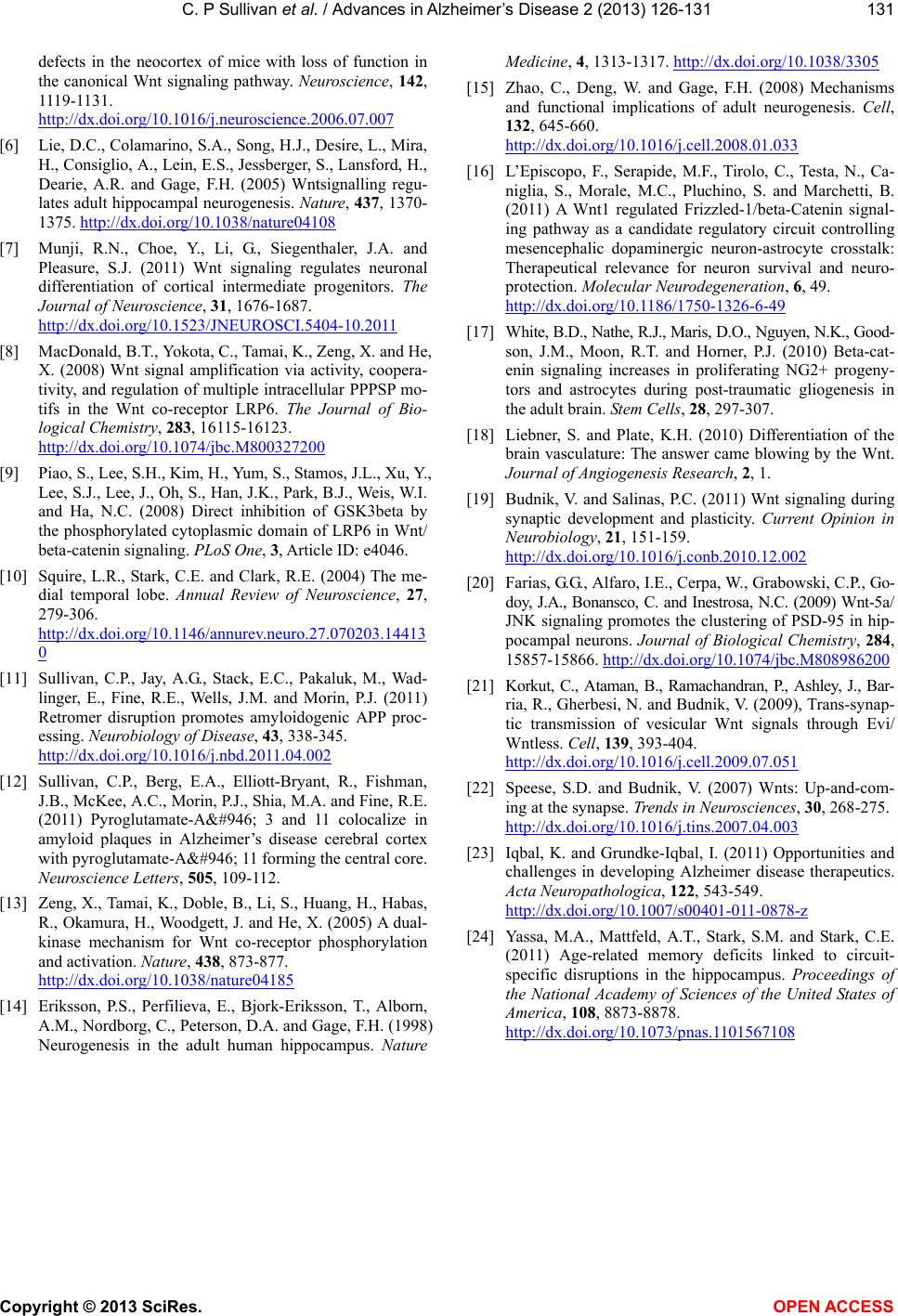
C. P Sullivan et al. / Advances in Alzheimer’s Disease 2 (2013) 126-13 1
Copyright © 2013 SciRes. OPEN ACCESS
131
defects in the neocortex of mice with loss of function in
the canonical Wnt signaling pathway. Neuroscience, 142,
1119-1131.
http://dx.doi.org/10.1016/j.neuroscience.2006.07.007
[6] Lie, D.C., Colamarino, S.A., Song, H.J., Desire, L., Mira,
H., Consiglio, A., Lein, E.S., Jessberger, S., Lansford, H.,
Dearie, A.R. and Gage, F.H. (2005) Wntsignalling regu-
lates adult hippocampal neurogenesis. Nature, 437, 1370-
1375. http://dx.doi.org/10.1038/nature04108
[7] Munji, R.N., Choe, Y., Li, G., Siegenthaler, J.A. and
Pleasure, S.J. (2011) Wnt signaling regulates neuronal
differentiation of cortical intermediate progenitors. The
Journal of Neuroscience, 31, 1676-1687.
http://dx.doi.org/10.1523/JNEUROSCI.5404-10.2011
[8] MacDonald, B.T., Yokota, C., Tamai, K., Zeng, X. and He,
X. (2008) Wnt signal amplification via activity, coopera-
tivity, and regulation of multiple intracellular PPPSP mo-
tifs in the Wnt co-receptor LRP6. The Journal of Bio-
logical Chemistry, 283, 16115-16123.
http://dx.doi.org/10.1074/jbc.M800327200
[9] Piao, S., Lee, S.H., Kim, H., Yum, S., Stamos, J.L., Xu, Y.,
Lee, S.J., Lee, J., Oh, S., Han, J.K., Park, B.J., Weis, W.I.
and Ha, N.C. (2008) Direct inhibition of GSK3beta by
the phosphorylated cytoplasmic domain of LRP6 in Wnt/
beta-catenin signaling. PLoS One, 3, Article ID: e4046.
[10] Squire, L.R., Stark, C.E. and Clark, R.E. (2004) The me-
dial temporal lobe. Annual Review of Neuroscience, 27,
279-306.
http://dx.doi.org/10.1146/annurev.neuro.27.070203.14413
0
[11] Sullivan, C.P., Jay, A.G., Stack, E.C., Pakaluk, M., Wad-
linger, E., Fine, R.E., Wells, J.M. and Morin, P.J. (2011)
Retromer disruption promotes amyloidogenic APP proc-
essing. Neurobiology of Disease, 43, 338-345.
http://dx.doi.org/10.1016/j.nbd.2011.04.002
[12] Sullivan, C.P., Berg, E.A., Elliott-Bryant, R., Fishman,
J.B., McKee, A.C., Morin, P.J., Shia, M.A. and Fine, R.E.
(2011) Pyroglutamate-Aβ 3 and 11 colocalize in
amyloid plaques in Alzheimer’s disease cerebral cortex
with pyroglutamate-Aβ 11 forming the central core.
Neuroscience Letters, 505, 109-112.
[13] Zeng, X., Tamai, K., Doble, B., Li, S., Huang, H., Habas,
R., Okamura, H., Woodgett, J. and He, X. (2005) A dual-
kinase mechanism for Wnt co-receptor phosphorylation
and activation. Nature, 438, 873-877.
http://dx.doi.org/10.1038/nature04185
[14] Eriksson, P.S., Perfilieva, E., Bjork-Eriksson, T., Alborn,
A.M., Nordborg, C., Peterson, D.A. and Gage, F.H. (1998)
Neurogenesis in the adult human hippocampus. Nature
Medicine, 4, 1313-1317. http://dx.doi.org/10.1038/3305
[15] Zhao, C., Deng, W. and Gage, F.H. (2008) Mechanisms
and functional implications of adult neurogenesis. Cell,
132, 645-660.
http://dx.doi.org/10.1016/j.cell.2008.01.033
[16] L’Episcopo, F., Serapide, M.F., Tirolo, C., Testa, N., Ca-
niglia, S., Morale, M.C., Pluchino, S. and Marchetti, B.
(2011) A Wnt1 regulated Frizzled-1/beta-Catenin signal-
ing pathway as a candidate regulatory circuit controlling
mesencephalic dopaminergic neuron-astrocyte crosstalk:
Therapeutical relevance for neuron survival and neuro-
protection. Molecular Neurodegeneration, 6, 49.
http://dx.doi.org/10.1186/1750-1326-6-49
[17] White, B.D., Nathe, R.J., Maris, D.O., Nguyen, N.K., Good-
son, J.M., Moon, R.T. and Horner, P.J. (2010) Beta-cat-
enin signaling increases in proliferating NG2+ progeny-
tors and astrocytes during post-traumatic gliogenesis in
the adult brain. Stem Cells, 28, 297-307.
[18] Liebner, S. and Plate, K.H. (2010) Differentiation of the
brain vasculature: The answer came blowing by the Wnt.
Journal of Angiogenesis Research, 2, 1.
[19] Budnik, V. and Salinas, P.C. (2011) Wnt signaling during
synaptic development and plasticity. Current Opinion in
Neurobiology, 21, 151-159.
http://dx.doi.org/10.1016/j.conb.2010.12.002
[20] Farias, G.G., Alfaro, I.E., Cerpa, W., Grabowski, C.P., Go-
doy, J.A., Bonansco, C. and Inestrosa, N.C. (2009) Wnt-5a/
JNK signaling promotes the clustering of PSD-95 in hip-
pocampal neurons. Journal of Biological Chemistry, 284,
15857-15866. http://dx.doi.org/10.1074/jbc.M808986200
[21] Korkut, C., Ataman, B., Ramachandran, P., Ashley, J., Bar-
ria, R., Gherbesi, N. and Budnik, V. (2009), Trans-synap-
tic transmission of vesicular Wnt signals through Evi/
Wntless. Cell, 139, 393-404.
http://dx.doi.org/10.1016/j.cell.2009.07.051
[22] Speese, S.D. and Budnik, V. (2007) Wnts: Up-and-com-
ing at the synapse. Trends in Neurosciences, 30, 268-275.
http://dx.doi.org/10.1016/j.tins.2007.04.003
[23] Iqbal, K. and Grundke-Iqbal, I. (2011) Opportunities and
challenges in developing Alzheimer disease therapeutics.
Acta Neuropathologica, 122, 543-549.
http://dx.doi.org/10.1007/s00401-011-0878-z
[24] Yassa, M.A., Mattfeld, A.T., Stark, S.M. and Stark, C.E.
(2011) Age-related memory deficits linked to circuit-
specific disruptions in the hippocampus. Proceedings of
the National Academy of Sciences of the United States of
America, 108, 8873-8878.
http://dx.doi.org/10.1073/pnas.1101567108